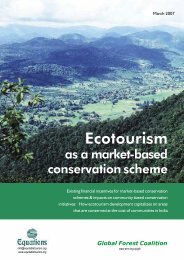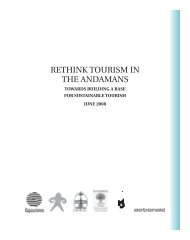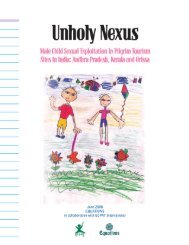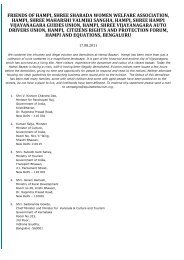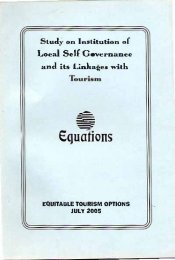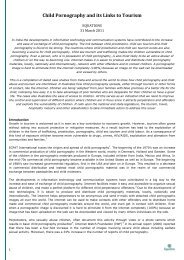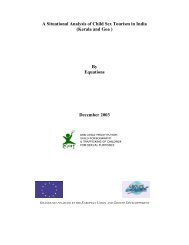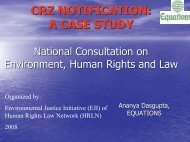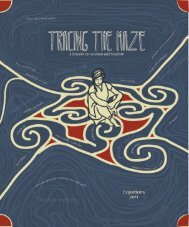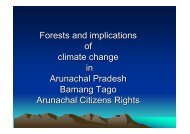Nilgiris Biosphere Reserve - Equitable Tourism Options
Nilgiris Biosphere Reserve - Equitable Tourism Options
Nilgiris Biosphere Reserve - Equitable Tourism Options
Create successful ePaper yourself
Turn your PDF publications into a flip-book with our unique Google optimized e-Paper software.
several States including Karnataka and Kerala have only aped this<br />
practice, despite the Indian Constitution under Article 244 providing for<br />
bringing indigenous peoples' villages under Schedule V areas ruled by<br />
Self-Governing institutions. Hence, to this day, Self-Rule has remained the<br />
abiding goal and demand of indigenous people all over the country. As in<br />
Nagarhole in the 90s, the struggle in the Muthanga Wild Life Sanctuary in<br />
Waynad last year was motivated by the goal of Self-Rule.<br />
Officially, the Muthanga forest forms a part of the Nilgiri <strong>Biosphere</strong> <strong>Reserve</strong><br />
and is a designated Elephant <strong>Reserve</strong>. Until two decades ago, Muthanga<br />
was a forestland with rich biodiversity. More than 3, 000 diverse species had<br />
frlade this area qualify for protection. However, disregarding the<br />
importance of the biosphere, 77 sq. km of the Muthanga Range was<br />
opened up for commercial plantations for feeding a single pulp factory of<br />
the Birlas, an Indian multinational business group. Soon there would be no<br />
natural forests left in nearly 40 per cent ofthe forest range. More than 3,500<br />
ha of forestland became completely barren. The water stream that<br />
separated the Bandipur <strong>Reserve</strong> of Karnataka and the Mudumalai <strong>Reserve</strong><br />
of Tamil Nadu from the Muthanga Range in Kerala locally called Mamana<br />
halla -- completely dried up as a result of the spread of eucalyptus<br />
plantations. The river is now nothing but a stretch of white sand. The marks<br />
of elephants trying to dig holes in the sand in search of water are evident in<br />
the dried up riverbed. Elephants frantically searching for water and<br />
crossing the Muthanga Range to reach the Noolpuzha River located east of<br />
Muthanga is what makes the Wild Life Sanctuary qualify as an Elephant<br />
<strong>Reserve</strong> and an elephant corridor. The plight of the elephants in the<br />
Wayanad Wild Life Sanctuary presents the other side of the saga of the<br />
disrupted lives in indigenous people in Muthanga as well as the whole<br />
State.<br />
Following a series of starvation deaths, the adivasis in Kerala had launched<br />
a struggle in August 2001 by setting up 'Refugee Camps' in front of the<br />
State Chief Minister'S residence. The struggle continued for 48 days forcing<br />
the Govt. of Kerala to promise disbursement of land and other rehabilitation<br />
measures for the adivasi people in the state. However, as the government<br />
did not keep its word even after a year, we were again forced to take to the<br />
path of struggle. And, as in Nagarhole, the indigenous people of Kerala<br />
decided to "Enter the Forests," our homeland, under the banner of the<br />
Adivasi Gothra Maha Sabha (AGMS). The Muthanga forest where we put<br />
, 75 N :Fmg Gwry



